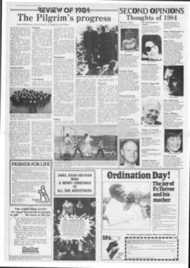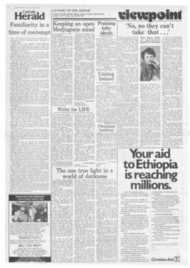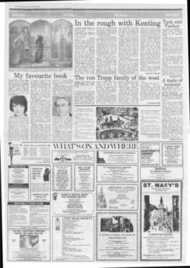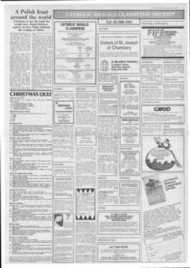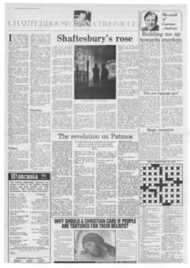Page 2, 21st December 1984
Page 2

Report an error
Noticed an error on this page?If you've noticed an error in this article please click here to report it.
Tags
Share
Related articles
Anglicans To Help Out With Shortage Of Papal Stewards
Pope's Mexico Visit Scaled Down After Health Fears
Africa Awaits The Pope's Impact
Vatican Lays Ground For Soviet Trip
Glemp Flies To Rome For Poland Visit Talks
The twin evils of mankind
Jonathan Petre looks at twelve hectic months in the Papal itinerary
FOR Pope John Paul II, 1984 has been a year of apocalyptic warnings.
Before the year had got properly underway, he had described the twin evils facing mankind as the escalation of the arms race and the ever-widening gulf between North and South. The latter was to take on an almost prophetic force as Ethiopia suffered its worst famine in living memory.
The Pope concluded the year by stressing similar themes in a major statement on the subject of sin and penance. Having described the "painful social phenomena of our time", to which be added the abuse of human rights and freedom, racial, religious and other forms of discrimination, and the use of torture, the Pope wrote: "The overwhelming power of this division makes the world in which we live a world shattered to its very foundations."
But to suggest, as some have, that the Pope's message is unremittingly pesimistic, possibly because of a personal conviction of the imminence of a nuclear Armageddon, is to miss the other side of his teaching, that mankind can avert selfdestruction and redeem itself through the power of reconciliation-: This was the common thread which ran throughout his four major foreign visits this year — to the Far East, Switzerland, Canada and the Dominican Republic and Costa Rica.
The beginning of the year was very much concentrated on the , gir
Is ip
# r "l''' Pope's devotion to Our Lady.
In mid-February he published a remarkable, personal 15,000-word letter on the meaning of suffering. The letter, Salvivici Dolores, revealed his feelings on pain and evil in the world, and was clearly based in part on his own experience after the attempt on his life in 1981.
In one of the most telling passages of the letter on the threat of nuclear war he wrote: "1 speak of the two world wars, the second of which brought with it a much greater harvest of death and a much heavier burden of human suffering."
He went on to attribute the flaws of modern society to the impending shadow of nuclear war.
"The second half of our century, in its turn, brings with it — as though in proportion to the mistakes and transgressions of our contemporary civilisation — such a horrible threat of nuclear war that we cannot think of this period except in terms of an incomparable accumulation of suffering, even to the possible destruction of humanity."
On March 25, the Pope, kneeling before the statue of Our Lady of Fatima before a crowd of 150,000 in St Peter's Square, begged Our Lady to free mankind from hunger and war.
The prayer was part of his "act of entrusting to the Blessed Virgin", a consecration of the world to Our Lady similar to that of Pius X11 in 1942 and of Pope John Paul himself in Fatima in 1982.
He thanked Our Lady for saving his life despite the assassination attempt which occurred on the feastday of Our Lady of Fatima, May 13.
Early April saw the long expected shake-up in the Curia, the Church's administrative bureaucracy.
Unsurprisingly, Archbishop Paul Marcinkus, who . headed the Vatican bank (the IOR) which has been implicated in fraud, was not made a Cardinal. Although he retained his post a pro-President of the Commission for the Vatican, both Cardinal Cassaroli and Cardinal Agnelo Rossi were appointed above him.
Archbishop Dermot Ryan of Dublin became head of the Congregation for Evangelisation.
The Pope became embroiled in international controversy in June when he met Mr P W Botha, the South African Prime Minister, just a few weeks after Mr Botha had met Mrs Margaret Thatcher in London. Immediately after the meeting the Pope reaffirmed his total opposition to apartheid, but not before some groups had criticised him for meeting Mr Botha at all. The papal statement pointed out that the Pope "receives heads of state and of governments and political personalities from the most diverse regimes if they request a meet ihg "Such audiences do not imply any papal approval for the policies of those received, but allow an opportunity for an exchange of views" the Statement said.
A further and more thorough attack on the policy of apartheid was launched by the Pope in July. The Church, he said, combats all forms of racial discrimination, and the Holy See was deeply disturbed at the level of suffering in Namibia and South Africa.
On the displacement of vast numbers of South African blacks to governmentdesignated "homelands", the Pope said: "The Holy See for its part, expressed its concern at procedures contrary to the dignity of individuals and whole communities. It extended hopes that a different policy will be established in order that a population already sorely tried, and whose right to be treated without discrimination is systematically flouted, may be spared further painful and tragic experiences."
The Pope's first visit of the year was both one of his longest and most dangerous. But it was also one of his most spectacular and caught the imagination of the media for days.
His 24,000-mile tour of the Far East took in South Korea (after a significant meeting with President Ronald Reagan in Alaska en route), the Solomon Islands, Papua New Guinea and Thailand.
In South Korea he canonised 103 Korean martyrs, the first such ceremony to take place outside the Vatican.
But his most colourful welcome came from the natives of Papua New Guinea, a Pacific island one and a half times the size of Italy, when he arrived int he capital of Port Moresby on May 7.
Grass-skirted natives in feathered headdresses mounted with crosses danced, sang and beat their drums as he descended from the aircraft.
In just over a months time he was travelling again, this time to Switzerland where he issued a rebuke to Swiss theologians, warning them to stay loyal to the Vatican.
His jet-set travel was temporarily frustrated the following month when the Soviet authorities decided not to allow him to visit Lithuania for the five hundredth anniversary of the death of St Casimir, the country's patron saint.
In September, however, the Pope completed an eleven-day tour of Canada which took him from coast to coast and during which he met fishermen, businessmen and Canadian Indians.
He left with the warning that rich nations must change their "unjust" economic systems because the gulf between rich and poor was more of a danger to world peace than the nuclear arms race.
His final foreign tour was based around a top level meeting with Latin American bishops in the Dominican Republic, but he took in Zaragosa, in Spain, and Costa Rica as well. His October visit was seen in the light of the Vatican's September pronouncements on theology.
Throughout the year, one country has dominated again his thoughts — his homeland, Poland. In November, Cardinal Glemp visited him in the Vatican to report on the situation after the murder of the pro-Solidarity priest Fr Jerzy Popieluszko.
Church-State relatons had been strengthened with a deal over farm aid, and the announcement of elections, but the priest's death cast the country into gloom.
By the end of the year, critics of the present Pope's attitude towards doctrinal reform were worried by two developments liberation the decision to lift the ban on the 1962 Tridentine Rite and the Pope's series of talks on marriage which stressed the value of chastity and questioned natural family planning.
His critics fears were worsened by remarks made by Cardinal Joseph Ratzinger, head of the Congregation for the Doctrine of the Faith, who appeared to blame the ills of the modern Church on the reforms ushered in by Vatican II.
It is this apparent change of direction at the top level of the Vatican to restore some of the Church's pre-conciliar values that will exercise the vigilance of many Catholics in 1985.
blog comments powered by Disqus





